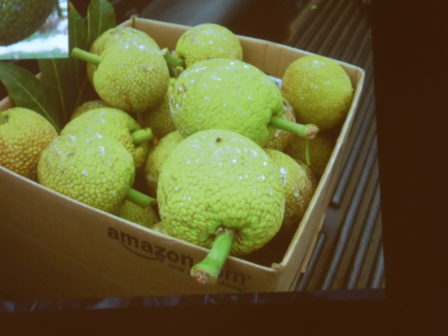Who Knew a Talk on Breadfruit Would Be So Interesting?

Breadfruit has many benefits, including it is attractive to the palate.
Mission Hills Garden Club’s last meeting before September featured Ian Cole of San Diego Botanic Garden and formerly with the Breadfruit Institute in Hana, Maui. His focus was managing the world’s largest collection of breadfruit as well as working with farmers and chefs; he was also involved in breadfruit trees and orchards’ propagation studies and management practices. Breadfruit is his passion, and he passed his enthusiasm to his audience.
Cole began with the physical aspects of breadfruit (Artocarpus altilis). It grows throughout Oceania preferring a tropical climate 70 to 90 degrees with prolific (59-119 inches per year) rainfall although some grow well with less. With irrigation, it grows in other warm climates. Breadfruit grows on a large, attractive tree. The Breadfruit Institute of the National Tropical Botanical Garden at Kahanu Garden in Hana, Maui is home to 120 varieties, 289 accessioned collections, and myriad informational resources.
There is much diversity among trees and fruits of breadfruit. The fruits can range from two to ten pounds. Its skin is patterned. Some have a spikey surface, others are smoother. Some have an orange peel texture. Shapes vary by variety from nearly kiwi shaped to lemon shaped, regular to irregular, gourd shape to pear.
The breadfruit tree is extremely versatile. Its wood and bark have been used in building materials: canoes, handicrafts, shade, and bark cloth. The wood of the breadfruit floats well, but it does not fare well with big waves as it is light weight. The bark can be harvested without harming the tree. It is used for clothing and paper. The tree’s sap produces latex for waterproof glue and caulking. It can even be used for chewing gum. The plant has medicinal uses as well. The male breadfruit flower is an excellent mosquito repellant and is safer than using DEET. In many areas where diseases such as dengue and malaria prevail, breadfruit flourishes as well. The plant can be used as fuel.
The fruit is used for food. Cole told us about the nutritional aspects of the breadfruit. One fruit of Ulu fiti can provide two adult women or one woman and two children with their daily iron needs. It has more potassium than ten bananas. One tree can feed a family of four for 50 years. Breadfruit could eradicate infant blindness in Africa in one generation. Over 80 per cent of people who are starving live in an area that is suitable for growing breadfruit.
In the Caribbean it was used as slave food; however, not until recently was it used by all classes. In the past decade, its uses have become more widespread. Breadfruit is gluten free and is very nutritious. The fruit’s uses and flavors change as it ripens. Some varieties can be quite tasty. One, when ripe, is like eating a creamy custard, according to Cole. The fruit can be baked, boiled, candied, fried, pickled, roasted, and steamed. It can be shredded, dried, and can be processed and ground into a gluten free flour. Today one can buy chips, bread, cakes, pies, pasta, cookies, even beer made from breadfruit. Cole’s wedding cake was made from breadfruit. Breadfruit flowers are edible. Even the leaves can be used as feed for animals. In addition to its versatility, breadfruit smells like freshly baked bread, hence the name.
Breadfruit originated in New Guinea where it has been grown for over 3,000 years. In the fourth century, Polynesians introduced it to Hawaii with bananas, coconut, ginger and sweet potatoes. Since then it has been carried all over the globe. The British explorers brought it to the western world in the 18th century. The HMS Bounty carried breadfruit. However, a tree from a seed needs sometimes nine years to produce fruit if it ever does so. Traditionally growers scarred a surface root and waited six or seven years for a young tree to grow from it.
Using micro propagation with a sterile tissue culture can speed this process to three years. In this process tiny cuttings of lateral buds are set into a gel. This enables greater production of disease resistant plants with a better chance of survival.
Cole is so passionate about breadfruit that he has friends ship its many forms to him which he then stores for his family’s use. It certainly sounds like a panacea for a host of problems!
For more information, please go to www.breadfruit.org or www.globalbreadfruit.com.
The September Garden Club meeting is membership renewal time. Some exciting speakers are on tap. Meetings are held at the church at 4070 Jackdaw in Mission Hills, between Fort Stockton and West Lewis. They begin at 6 and end by 8 p.m. Refreshments are provided, and members are free. Guest fees are $10 which may be applied to your membership if you join that evening.
Category: Events, Featured Articles







